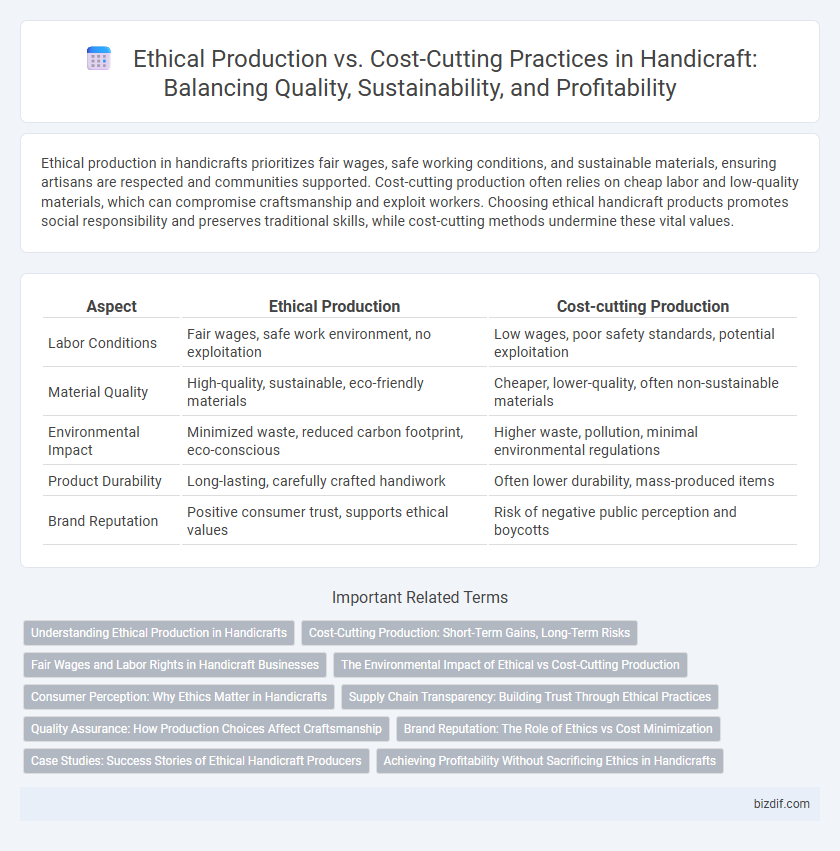Ethical production in handicrafts prioritizes fair wages, safe working conditions, and sustainable materials, ensuring artisans are respected and communities supported. Cost-cutting production often relies on cheap labor and low-quality materials, which can compromise craftsmanship and exploit workers. Choosing ethical handicraft products promotes social responsibility and preserves traditional skills, while cost-cutting methods undermine these vital values.
Table of Comparison
| Aspect | Ethical Production | Cost-cutting Production |
|---|---|---|
| Labor Conditions | Fair wages, safe work environment, no exploitation | Low wages, poor safety standards, potential exploitation |
| Material Quality | High-quality, sustainable, eco-friendly materials | Cheaper, lower-quality, often non-sustainable materials |
| Environmental Impact | Minimized waste, reduced carbon footprint, eco-conscious | Higher waste, pollution, minimal environmental regulations |
| Product Durability | Long-lasting, carefully crafted handiwork | Often lower durability, mass-produced items |
| Brand Reputation | Positive consumer trust, supports ethical values | Risk of negative public perception and boycotts |
Understanding Ethical Production in Handicrafts
Ethical production in handicrafts emphasizes fair wages, safe working conditions, and sustainable sourcing of materials to support artisans' well-being and preserve cultural heritage. This approach fosters transparency and community empowerment, often resulting in higher-quality, unique products that reflect traditional craftsmanship. Understanding these principles highlights the contrast with cost-cutting production, which can compromise worker rights and environmental responsibility for cheaper mass production.
Cost-Cutting Production: Short-Term Gains, Long-Term Risks
Cost-cutting production in handicraft often prioritizes immediate financial savings by reducing material quality and labor standards, resulting in short-term gains. This approach can compromise product durability, artisan welfare, and brand reputation, leading to long-term risks such as customer dissatisfaction and decreased market trust. Sustainable growth in the handicraft industry depends on balancing cost efficiency with ethical practices to maintain quality and artisan livelihoods.
Fair Wages and Labor Rights in Handicraft Businesses
Fair wages and labor rights are fundamental in ethical production within handicraft businesses, ensuring artisans receive just compensation for their skilled work. Cost-cutting production often compromises these standards, leading to underpayment, poor working conditions, and exploitation. Prioritizing ethical practices not only supports sustainable livelihoods but also enhances product quality and brand reputation.
The Environmental Impact of Ethical vs Cost-Cutting Production
Ethical production in handicrafts emphasizes sustainable sourcing of materials, reducing waste and minimizing carbon footprints through eco-friendly practices, which significantly lowers environmental impact. Cost-cutting production often relies on mass production techniques, cheaper synthetic materials, and less stringent environmental regulations, leading to higher pollution levels and resource depletion. Choosing ethical production supports biodiversity and long-term ecological balance, contrasting sharply with the environmental degradation commonly associated with cost-cutting methods.
Consumer Perception: Why Ethics Matter in Handicrafts
Consumers increasingly prioritize ethical production in handicrafts, associating it with fair labor practices, sustainable sourcing, and cultural preservation. Ethical production fosters trust and brand loyalty by ensuring artisans receive fair wages and work in safe conditions, contrasting sharply with cost-cutting methods that often exploit workers and degrade quality. This perception drives demand for authentic, responsibly made products, influencing purchasing decisions and elevating the value of ethical craftsmanship in the global market.
Supply Chain Transparency: Building Trust Through Ethical Practices
Supply chain transparency in handicraft production ensures that every stage, from sourcing raw materials to final assembly, adheres to ethical labor standards and environmental practices. Transparent supply chains build consumer trust by providing verifiable information on fair wages, safe working conditions, and sustainable sourcing. Emphasizing ethical production over cost-cutting methods minimizes exploitation and supports artisans' livelihoods, fostering a sustainable and responsible handicraft industry.
Quality Assurance: How Production Choices Affect Craftsmanship
Ethical production in handicrafts emphasizes quality assurance by using skilled artisans and sustainable materials, resulting in durable and authentic products that honor traditional techniques. Cost-cutting production often sacrifices craftsmanship quality through mass production, cheaper materials, and limited attention to detail, leading to inferior and less unique items. Choosing ethical production methods ensures the preservation of cultural heritage and supports fair labor practices while maintaining high standards in design and durability.
Brand Reputation: The Role of Ethics vs Cost Minimization
Ethical production in handicrafts significantly enhances brand reputation by fostering consumer trust and loyalty through sustainable practices and fair labor conditions. Brands that prioritize cost-cutting at the expense of ethics risk damaging their public image due to exploitation concerns and poor product quality. Commitment to ethical standards not only supports artisans but also differentiates the brand in a competitive market focused on responsible consumption.
Case Studies: Success Stories of Ethical Handicraft Producers
Ethical handcraft producers like Ten Thousand Villages and SERRV have demonstrated that prioritizing fair wages and sustainable materials leads to long-term business success and community empowerment. These case studies reveal how investing in artisan well-being enhances product quality and brand loyalty, outperforming competitors who rely on cost-cutting measures. Consumer demand for transparency and socially responsible products continues to drive growth in ethical handicraft markets.
Achieving Profitability Without Sacrificing Ethics in Handicrafts
Ethical production in handicrafts emphasizes fair wages, sustainable materials, and preserving traditional techniques, creating long-term value and consumer trust. Cost-cutting production often undermines these principles by exploiting labor and using inferior materials, risking brand reputation and market position. Balancing profitability with ethical practices requires transparent supply chains and investing in artisan communities to maintain quality and social responsibility.
Ethical Production vs Cost-cutting Production Infographic

 bizdif.com
bizdif.com